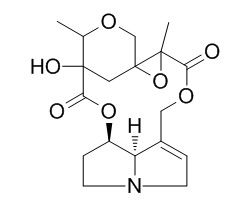Adonifoline
Adonifoline is a hepatotoxic pyrrolizidine alkaloid.
Inquire / Order:
manager@chemfaces.com
Technical Inquiries:
service@chemfaces.com
Tel:
+86-27-84237783
Fax:
+86-27-84254680
Address:
1 Building, No. 83, CheCheng Rd., Wuhan Economic and Technological Development Zone, Wuhan, Hubei 430056, PRC
Providing storage is as stated on the product vial and the vial is kept tightly sealed, the product can be stored for up to
24 months(2-8C).
Wherever possible, you should prepare and use solutions on the same day. However, if you need to make up stock solutions in advance, we recommend that you store the solution as aliquots in tightly sealed vials at -20C. Generally, these will be useable for up to two weeks. Before use, and prior to opening the vial we recommend that you allow your product to equilibrate to room temperature for at least 1 hour.
Need more advice on solubility, usage and handling? Please email to: service@chemfaces.com
The packaging of the product may have turned upside down during transportation, resulting in the natural compounds adhering to the neck or cap of the vial. take the vial out of its packaging and gently shake to let the compounds fall to the bottom of the vial. for liquid products, centrifuge at 200-500 RPM to gather the liquid at the bottom of the vial. try to avoid loss or contamination during handling.
The Journal of Supercritical Fluids2021, 176:105305.
J Agric Food Chem.2024, acs.jafc.4c01387.
Molecules.2015, 20(10):19172-88
Acta Physiologiae Plantarum2016, 38:7
Front. Plant Sci.2022, 13:757852.
Food Research International2023, 113792.
Foods.2021, 10(11):2754.
Nat Prod Commun.2014, 9(5):679-82
Int J Mol Sci.2021, 22(21):11836.
J Korean Soc Food Sci Nutr2020, doi: 10.3746.
Related and Featured Products
Anal Bioanal Chem. 2011 Jul;401(1):275-87.
The comparative pharmacokinetics of two pyrrolizidine alkaloids, senecionine and adonifoline, and their main metabolites in rats after intravenous and oral administration by UPLC/ESIMS.[Pubmed:
21573843]
This study determined the differences in the in vivo pharmacokinetic behavior of senecionine (SEN), Adonifoline (ADO), and their main metabolites in rats after intravenous administration and oral administration by ultraperformance liquid chromatography/electrospray ionization mass spectrometry.
METHODS AND RESULTS:
Upon intravenous administration and oral administration of SEN and Adonifoline, significant differences in pharmacokinetics were observed, with the SEN and Adonifoline being absorbed fast with lower bioavailability and being quickly metabolized to PA N-oxides and hydroxylation products of PAs or their N-oxides. It could be seen that the plasma concentration ratio of senecionine N-oxide (SEN-NO) to SEN (C (SEN-NO)/C (SEN)) was significantly larger than that for Adonifoline N-oxide (ADO-NO) and Adonifoline (C (ADO-NO)/C (ADO)) (P < 0.001) for both dosing routes in rats. The high N-oxygenation activity and extensive toxicity of SEN, compared with Adonifoline, in rats raised the question of whether or not the higher metabolic rate of SEN in rats in vivo was related to its potent toxicity. The toxicity of SEN-NO and Adonifoline-NO needs to be evaluated further and compared in vitro/in vivo.
CONCLUSIONS:
This study was most helpful for interpreting the metabolism of metabolic bioactivation and detoxication, and toxicity differences among SEN, Adonifoline and other PAs.
Chem Res Toxicol. 2010 Mar 15;23(3):591-9.
Glucuronidation, a new metabolic pathway for pyrrolizidine alkaloids.[Pubmed:
20092275 ]
Pyrrolizidine alkaloids (PAs) possess significant hepatotoxicity to humans and animals after metabolic activation by liver P450 enzymes. Metabolism pathways of PAs have been studied for several decades, including metabolic activation, hydroxylation, N-oxidation, and hydrolysis. However, the glucuronidation of intact PAs has not been investigated, although glucuronidation plays an important role in the elimination and detoxication of xenobiotics.
METHODS AND RESULTS:
In this study, PAs glucuronidation was investigated, and three important points were found. First, we demonstrated that senecionine (SEN)-a representative hepatotoxic PA-could be conjugated by glucuronic acid via an N-glucuronidation reaction catalyzed by uridine diphosphate glucuronosyl transferase in human liver microsomes. Second, glucuronidation of SEN was catalyzed not only by human but also other animal species and showed significant species differences. Rabbits, cattle, sheep, pigs, and humans showed the significantly higher glucuronidation activity than mice, rats, dogs, and guinea pigs on SEN. Kinetics of SEN glucuronidation in humans, pigs, and rabbits followed the one-site binding model of the Michaelis-Menten equation, while cattle and sheep followed the two-sites binding model of the Michaelis-Menten equation. Third, besides SEN, other hepatotoxic PAs including monocrotaline, Adonifoline, and isoline also underwent N-glucuronidation in humans and several animal species such as rabbits, cattle, sheep, and pigs.
Rapid Commun Mass Spectrom. 2009 Dec;23(24):3907-16.
Identification of metabolites of adonifoline, a hepatotoxic pyrrolizidine alkaloid, by liquid chromatography/tandem and high-resolution mass spectrometry.[Pubmed:
19918941 ]
Hepatotoxic pyrrolizidine alkaloid (HPA)-containing plants have always been a threat to human and livestock health worldwide. Adonifoline, a main HPA in Senecio scandens Buch.-Ham. ex D. Don (Qianli guang), was used officially as an infusion in cases of oral and pharyngeal infections in China.
METHODS AND RESULTS:
In this study in vivo metabolism of Adonifoline was studied for the first time by identifying the metabolites of Adonifoline present in bile, urine and feces of rats using liquid chromatography/electrospray ionization tandem mass spectrometry (LC/ESI-MS(n)) (ion trap) as well as liquid chromatography/electrospray ionization high-resolution mass spectrometry (LC/ESI-HRMS) (quadrupole-time of flight).
In total 19 metabolites were identified and, among them, retronecine-N-oxides were confirmed by matching their fragmentation patterns with their fully characterized synthetic compounds.
CONCLUSIONS:
These metabolites are all involved in both phase I and phase II metabolic processes and the principal in vivo metabolism pathways of Adonifoline were proposed.



